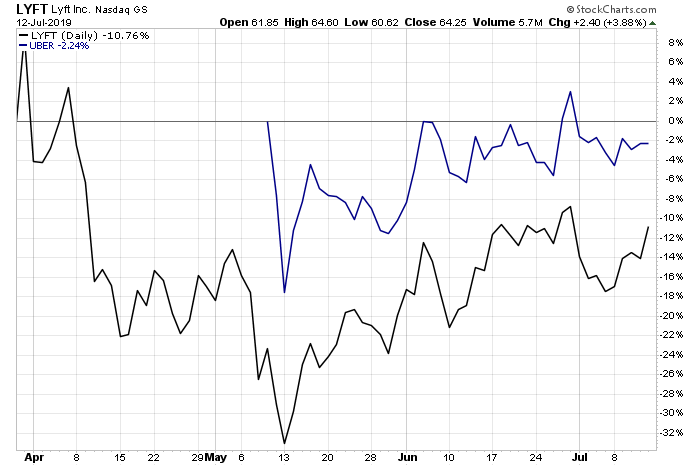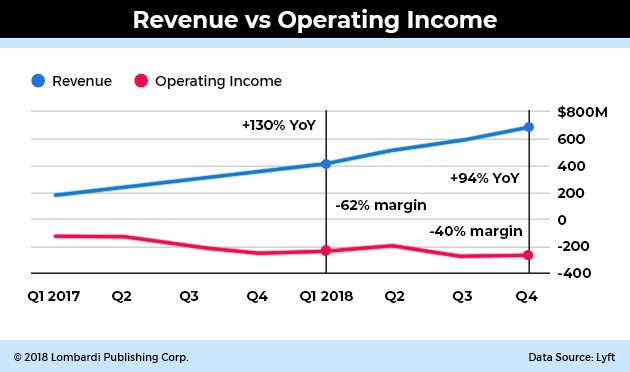Ridesharing Apps: Are Lyft and Uber Set to Dominate 2020?
Marijuana Business, Stocks, Finance, & Investing July 19, 2019 MJ Shareholders 0


How Will UBER and LYFT Stock Perform in 2020?
Ridesharing stocks are fresh on the market, but they’ve already caused quite a bit of consternation among investors that thought they were getting in on another tech boom. While both the Uber Technologies Inc (NYSE:UBER) and the Lyft Inc (NASDAQ:LYFT) initial public offerings (IPOs) left much to be desired, the two ridesharing stocks have since rebounded, gaining big in recent months. I believe that this is just the start of a strong comeback for these hot tech stocks.
First, the backstory: how did UBER stock and LYFT stock end up in this predicament?
Frankly, there’s a confluence of factors that led to the early declines in both LYFT stock and UBER stock, but to sum it up succinctly: hype and valuation.
These companies hit the market hot and have dominated conversation for years. Speculation over the Uber valuation—which only kept getting higher and higher and at one point was projected to be over 12 figures ($100.0-billion-plus)—and how ridesharing apps represented the future of taxis meant that investors were already very hot on what looked to be one of the most exiting tech stocks to emerge in years.
After all, this wasn’t some gimmicky social media company that was peddling improbably growth and dubious monetization plans. Instead, this was a real company offering a real service that millions of people made use of every day.
Only, they did share one thing in common with those countless other claimants to the “next top tech stock” title: they spent money by the truckload.
Uber especially. Despite its international reach and ubiquity, the tech giant has yet to make a single dollar.
And that combination of massive expectations, no profitability yet (or in the near future) and a sky-high valuation, led to weak Uber and Lyft IPOs.
Chart courtesy of StockCharts.com
As can be seen in the chart above, Lyft was already off to a poor start post-IPO, only to have its troubles intensify when UBER stock hit the market with a whimper rather than a bang.
The lack of enthusiasm brought down both companies, sending shares falling for months on end, leading to massive losses to anyone who invested in the early days and who sold at the lowest point.
The panic sellers are likely kicking themselves because, as you can see above, things have begun to turn around for both UBER stock and LYFT stock.
Uber and Lyft are down two percent and 10%, respectively, since they hit the market. While obviously those aren’t good numbers, considering they were formerly down double-digits, this is a nice change of pace.
So what accounts for this comeback? Simple: with the panic out of the way, investors are rediscovering what made these companies to attractive in the first place.
Frankly, these are solid businesses with international reach and huge potential based on technological advances.
As I have previously discussed, what exactly makes these companies so impressive is that they share huge chunks of the U.S. market and are fighting one another over control of the global market.
Lyft recently claimed to have a 35% share of the U.S. ridesharing market, up from 20% in the previous 18 months. (Source: “Lyft claims it now has more than one-third of the US ride-sharing market,” CNBC, May 14, 2018.)
While those numbers were somewhat in dispute (some place it closer to a 70/30 split favoring Uber), what we’re left with is the fact that no matter how you slice it, this is very much an Uber- and Lyft-flavored pie. There is no true alternative to these ridesharing stocks.
And both companies are looking to expand into other areas of the transportation sector. Both Uber and Lyft are looking into bike-sharing as an expansion of their respective businesses, with Lyft scoring a big win when it acquired North America’s largest bike-sharing operator, Motivate. (Source: “Lyft Bets Big On Bikes In NYC, And Uber Is None Too Happy,” Wired, November 29, 2018.)
And as mentioned above, both are heavily invested in new technology. Namely autonomous driving.
Lyft has partnered with Waymo LLC, the autonomous vehicle division of Alphabet Inc (NASDAQ:GOOG). Alphabet, you’ll remember, is the parent company of Google. (Source: “Lyft and Waymo Reach Deal to Collaborate on Self-Driving Cars,” The New York Times, May 14, 2017.)
Not to mention that Uber and Lyft’s operating losses—while dismal, considering these are multi-billion-dollar companies—are trending in the right direction. (Source: “Lyft Fills In Some Blanks, But Not the Big One,” Bloomberg, March 18, 2019.)
See the chart below for Lyft’s improving revenue versus costs:
The overall impression, then, is that these companies have a lot to offer, even if there are risks. And now that they’ve taken their lumps out of the gate, I believe that UBER stock and LYFT stock are becoming more appropriately priced in the eyes of the market; the sooner that happens, the sooner we can expect to see these companies back on top.
Analyst Take
The question I posed at the beginning of this article remains unanswered. Will Uber Technologies Inc and Lyft Inc dominate the stock market in 2020? Frankly, it’s hard to say, but for those looking to make a more speculative approach, I would bet that they will.
Again, these are volatile stocks in a new sector that is prone to swings. But I believe that investors who jump in now and don’t mind a bit of a roller coaster ride could see strong to moderate gains by the end of 2020.
I’m hotter on Lyft versus Uber precisely due to the fact that Uber still has to contend with an absurd valuation for a company that is making zero dollars in profit.
Both companies are ripe with potential, but at the end of the day, there are several roadblocks that could stall UBER stock and LYFT stock on the speedway. But if the two ridesharing stocks can begin to regain investor confidence and build up momentum, that could result in strong performances.
MJ Shareholders
MJShareholders.com is the largest dedicated financial network and leading corporate communications firm serving the legal cannabis industry. Our network aims to connect public marijuana companies with these focused cannabis audiences across the US and Canada that are critical for growth: Short and long term cannabis investors Active funding sources Mainstream media Business leaders Cannabis consumers












No comments so far.
Be first to leave comment below.